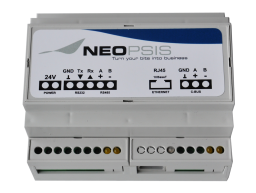C-Bus Connectivity Kit
Overview
The C-Bus Connectivity Kit consists of two components. The Intelligent External Converter (IEC) and the Niagara Driver.
Intelligent External Converter
The Intelligent External Converter (IEC) device handles all C-Bus events and provides a change notification service for the Niagara driver.

The change of state notification guarantees short response times. IEC can connect with up to 29 Excel controllers with max. 3’000 data points. The IEC communicates with the Niagara station either over a serial line or a TCP/IP connection. The IEC is manufactured by the Czech company KZK Ltd. (www.softyon.com). In addition to the Niagara driver, they offer an OPC server. The OPC server is not a subject of this guide.
The IEC is available as a DIN rail mounted box. In the past, Neopsis provided the IEC as the Jace option card for installations in the old Jace 2xx/3xx and 6xx devices. The option card is no more manufactured and is available only as a replacement part.
All converters, regardless of the form, have the same functionality and use the same Niagara driver.
Niagara Driver
Niagara driver for the IEC supports platforms NiagaraAX and Niagara4.

The driver runs on all Tridium stations such as Jace or Supervisor and perfectly integrates into the Niagara Workbench. Seamless integration into the framework, device and point discovery, alarm integration and time program maintenance lower the engineering costs, minimise the learning curve and provide an efficient way to integrate the C-Bus with other protocols supported by Niagara.
- In combination with the IEC the driver can control up to 29 Excel 5000 controllers
- The driver communicates with the IEC using either a serial port (RS-232, RS-485) or TCP/IP
- The driver can read and write the following C-Bus point types
- Digital Input
- Digital Output
- Analog Input
- Analog Output
- Pseudo Digital (Virtual) and Pseudo Analog (Virtual)
- Totaliser (Slow & Fast)
- Pulse, Multistate
- The driver supports C-Bus speed up to 76800 baud
- The driver supports reading and writing of the extended attributes mode, inAlarm, HighLimit1, HighLimit2, LowLimit1, LowLimit2, AlarmDelay, SensorOffset, AccumulatedRuntime, ServiceInterval, TimeSinceServiced, SuppressAlarm, PointEnabled, RuntimeEnable, ActiveState, AlarmType, AlarmStatus, TrendHysteresis and AlarmHysteresis
- The driver supports editing of daily, weekly and yearly (daily exceptions) time programs
- The driver supports writing C-Bus alarms into the Niagara history table
- The driver supports device and point auto-discovery, import of engineering units, point descriptions and alarm texts
